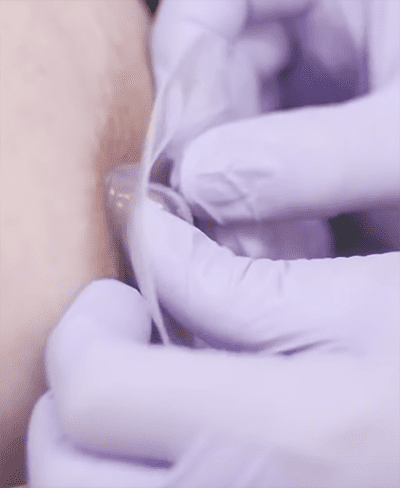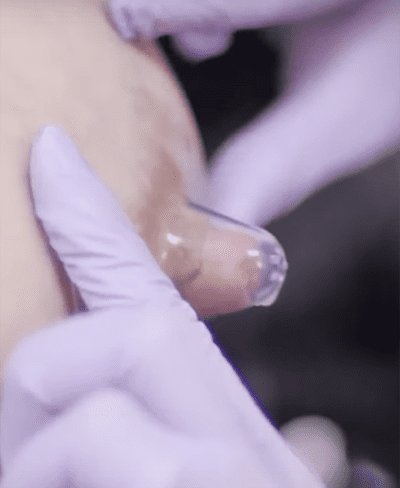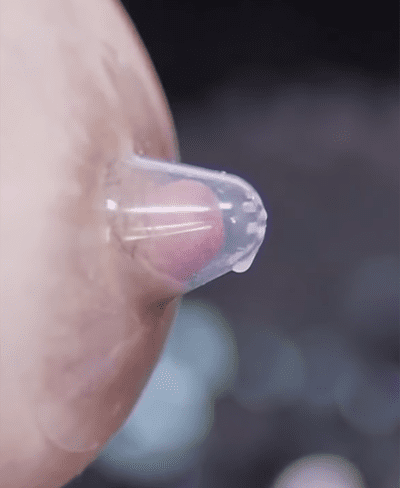COMMON CONDITIONS
How to Use Nipple Shields
summary
A nipple shield is a thin piece of silicone that is placed over a nipple to help a baby latch onto and transfer milk. Nipple shields are intended to be used only for a short period of time, so having a plan to wean off this tool is important. Assessment by a qualified lactation professional is warranted to help plan for effective nipple shield use.
Flat or inverted nipples. Babies need to be able to get a sufficient amount of the areola into their mouths so they can compress the breast behind the nipple — not just put pressure on the nipple. This is called a “deep latch.” Nipples can seem “flat” when breasts are engorged or tight. Though it is overdiagnosed, some nipples may be flat or even go inward, which can make a deep latch more difficult. A nipple shield can give a baby an outward nipple shape to feel deeply in their mouths, which stimulates the suck reflex.
Late preterm or preterm babies. Latching can be tough when you tire quickly, and preterm babies may have a relatively weak suck. Nipple shields not only help increase suck strength, it also provides palette stimulation that increases the desire to suck. Using a nipple shield for a time can help a baby build stamina for breastfeeding.
Very painful breastfeeding. A nipple shield can help nipple pain by offering a layer of temporary protection, but will not fix the underlying reason that latching is painful. If breastfeeding is painful, consult with a qualified lactation professional for further evaluation.
Remember, painful breastfeeding can be caused by many things — including ineffective positioning that leads to a shallow latch, a tongue tie or lip tie, tight jaw muscles, and more. Think of a nipple shield like a band-aid. It may offer some relief, but if the underlying cause of the pain is still present, then that pain will return.
Equipment
Correctly sized nipple shield
test
Steps
1.
1. Start by selecting the correct size. Nipple shields are typically sold in 16mm, 20mm, and 24mm. To find your fit, think about the size of your nipple, not your breast.
Here is a good visual guideline:
If your nipple base is the diameter of your pinky finger= 16mm
If your nipple base is the diameter of your index finger= 20mm
If your nipple base is the diameter of your thumb= 24mm
2.
2. Next, put it on your nipple. Roll the nipple shield so that it is nearly inside-out. Apply it to your nipple by rolling it on. Check to see that your nipple is inside the tip of the shield as shown.



2.
3. You can also try hand-expressing a drop of breastmilk to wet the areola. This can help the shield stay put when applied to the breast.
3.
4. Latch the baby on as deeply as you can. If it still doesn’t feel right, pull the baby in closer to achieve a deeper latch. Adjust your position until you feel comfortable. You can also take baby off the breast and try latching again.
4.
5. If comfort isn’t achieved by re-latching or adjusting position, you may need a different nipple shield size.
FOLLOW UP
Anytime a nipple shield is in use, it is recommended to work with a qualified lactation professional for optimal breastfeeding outcomes. Because nipple shields are often used when another issue is present, it may be advised that lactating parentspump and/or supplement during use. It is also recommended to have a plan for weaning away from the nipple shield as soon as the feeding pair is able. Your lactation professional can help you formulate a plan and evaluate when and how to wean off the nipple shield.
RESEARCH
The Cochrane Review, 2015: https://www.ncbi.nlm.nih.gov/pmc/articles/PMC4607874/
This and other how-to guides are available as free downloads

